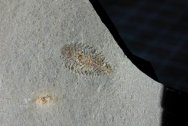 Description:
This is the first and only good quality specimen of this genus found
at the Giza digging site. It is complete and well preserved. I believe
the genus to be correct for this specimen. The species declaration
is only for comparison to a similar looking one found in the Lower
Ordovician. of Slemmestad, Norway. Description:
This is the first and only good quality specimen of this genus found
at the Giza digging site. It is complete and well preserved. I believe
the genus to be correct for this specimen. The species declaration
is only for comparison to a similar looking one found in the Lower
Ordovician. of Slemmestad, Norway.
Without
question the most productive graptolite area in the United States
is the Fillmore Formation located in the Ibex area of Utah. Our
quarry, the Pyramid Ridge Quarry has an abundance of graptolite
genera. So far we have discovered about five genera. Published information
is difficult to find and we are still in the middle of our research.
We hope to involve interested academics in this process. Though
our trilobites garnish the most attention, our graptolites should
not be overlooked. The specialist collector will certainly be interested
in our diversity of offerings of these enigmatic creatures.
Graptolites (literally translated "writing
on rock") are an extinct group of Paleozoic colonial organisms,
most often found as thin carbonized films in various shales or limestones
from the Cambrian to the Carboniferous. It is believed that they
were either planktonic (floating) or benthonic (bottom dwelling)
in habit. They are classified in the hemichordates due to their
affinity to a modern group of hemichordates, the pterobranchs, and
it is believed that they were filter-feeders as are their modern
counterparts. An entire graptolite colony is termed a rhabdosome,
composed of a variable number of stipes diverging from the initial
individual of the colony, the sicula. The small "sawtooth"
like structures along the stipes are termed thecae (singular theca.
Millard County, Utah is famous for the quality,
and quantity of its Middle to Upper Middle Cambrian period trilobites.
The Ordovician period is also well known, but far fewer trilobites
are known and available from these areas. The associates at Fossil
Mall have recently leased the most famous and productive of the
Ordovician quarry sites. We have named it the Pyramid Ridge Quarry.
It is almost guaranteed that any Utah Ordovician trilobite in the
world today has come from our quarry site. The trilobites are not
common, and intense labor is required to extract quality specimens.
We hope to provide you now and in the future with some of the spectacular
fauna to be found at the Pyramid Ridge Quarry.
|
